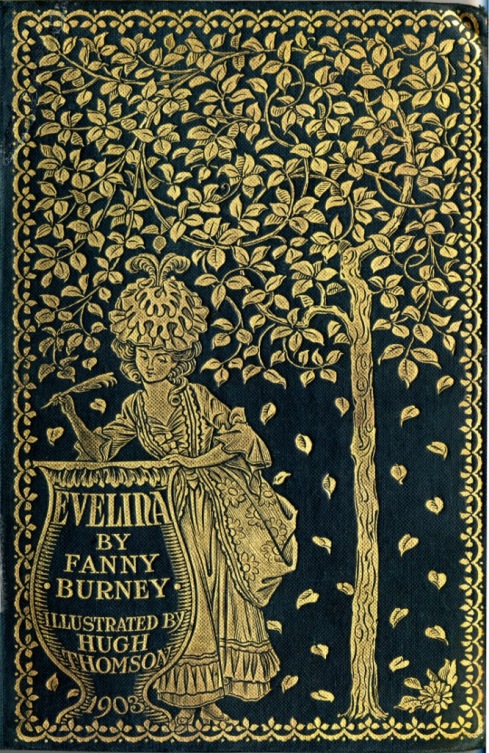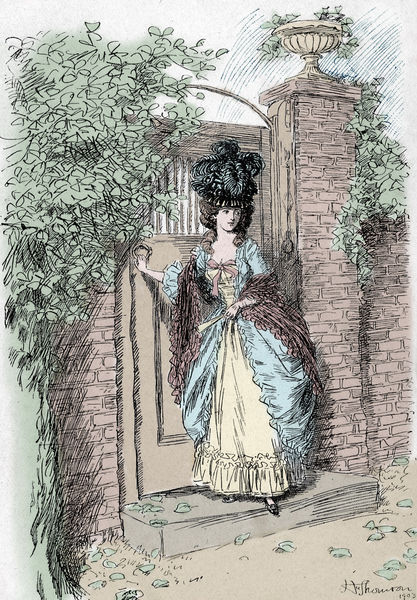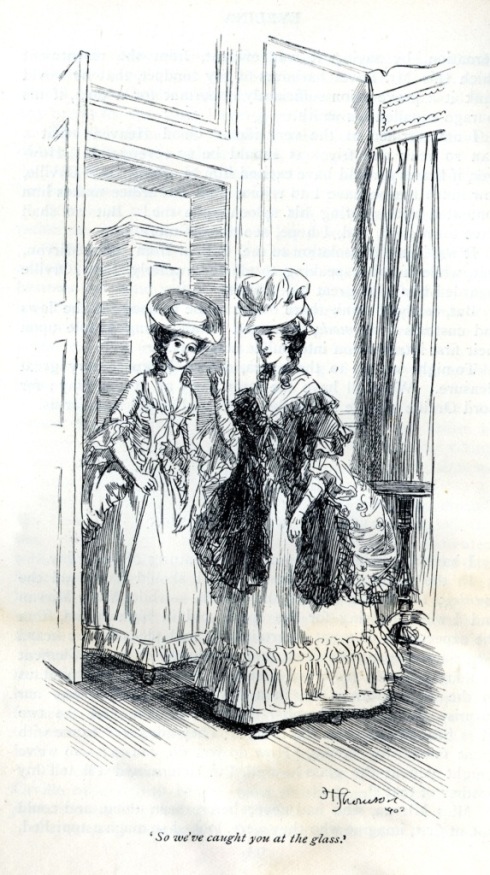First, let’s sort out the local connection. Fanny, or more properly Frances, Burney the 18th century novelist lived in Chelsea twice. Once with some of her family in an apartment at Chelsea College when she finished working as Second Keeper of the Robes for Queen Charlotte, and later in her life at an address in Lower Sloane Street.
Which is good for me because although Frances Burney / Madame D’Arblay was a very remarkable woman and one of the first great English novelists, this week’s post is really about a particular edition of her first novel Evelina.
Now I’ve written nearly 200 of these posts you must have had all my basic thoughts and the variations on them. One thing I seem to say quite often is that things in the past resemble things in the present. People seem to do the same things in the past as they do now and the things they entertained themselves with are like the things we use now for the pursuit of happiness.
One day I went to the Reference store looking for a book illustrated by someone who is nothing to do with this post. In an odd corner of the Dewey Decimal Classification you can find novels, plays and poetry all together at one number, 741.64 classified by the artist who illustrated them. And there I found a 1903 one volume edition of Fanny Burney’s Evelina illustrated by Hugh Thomson.
The late 19th and early 20th century was a boom time for illustrated books including new editions of classic works.
Evelina is a long narrative about a naive young woman trying to find her place in the high society of 18th century England. She encounters a number of unreliable and sometimes lecherous suitors, highly strung older women,embarrassing relatives and her one true love, from whom she is separated by circumstance until the end. There is even a mystery about her parentage to be solved.
But I didn’t actually read Evelina. I just looked at the pictures.
This edition is lavishly illustrated by Thomson, full of pictures (more than 50) of its young heroine. So many in fact that I began to see it as an early form of the graphic novel, following the protagonist through her series of adventures. To illustrate my point I will have to set before you quite a few of pictures of the eponymous heroine. Thomson’s skill is to make her attractive and glamorous in a variety of moods. Just like the heroine of a comic. Which gets me back to the pleasures of the past resembling the pleasures of the present.
Thomson of course is looking back at the 18th century from a modern era. From 1903 as well as from 2015 it looks like an exotic and sophisticated time, whose inhabitants gave themselves over to the pleasures of witty speech, flirting with the opposite sex and promenading around London looking good. I remember that impression gained from books (and films) like Tom Jones, the memoirs of Casanova, and the introductions to Penguin editions of books like Humphrey Clinker (Smollet – another Chelsea man) and Tristram Shandy. I’ve always been a great reader of introductions.
Evelina and her friend join the throng at Ranelagh Gardens – one of the great places to see and be seeen. (See this post, this one, or this one for more 18th century amusement.)
There are Balls and Assemblies where the fashionable elite and their hangers on disport themselves.
There is some physical comedy, on this occasion on board a coach.
Fashion notes from new friends
Life at the theatre, Burney’s great passion. (She wrote a number of plays, very few of which were ever performed.)
Virtue threatened by an unwelcome suitor (aboard another coach).
Some outdoor scenes, with a comedy buffoon.
And indoors again with yet another unwelcome suitor.
Introductions….
Colourful transport…
A bit of running around in panic.
Uncertainty….
Jeopardy….
The heroine turns feisty.
Then gets in more trouble, this time in Kensington Gardens.
Where some inclement weather causes more panic.
After all her tribulations she returns to the security of home.
And the unwelcome attentions follow her.
She goes out again with some unsuitable companions.
But finally. she is reunited with the one good suitor. Reconciliation, and a happy ending
And then there’s the funny bit at the end.
Featuring that old standby the amusing monkey.
These illustrations are all in the right sequence so although I can’t show them all I hope that you like me can get a decent idea of the story. Or any other story you can make up based on the pictures. Some books are just too long to read the whole thing so I was really very impressed with Thomson’s efforts which not only saved me the trouble but to me have something of the pace of a modern graphic novel.
Postscript
All we need now to save me from having to read the book which I might eventually is a TV adaptation to give the costume designers something to get their teeth into. I haven’t seen a good adaptation of an 18th century novel since the last TV version of Tom Jones , or that version of Fanny Hill on BBC4.
I’m not a complete philistine. I do read some long books. I read all 1000 pages of Jonathan Strange and Mr Norrell (very nearly an 18th century narrative) so I’m in a good position to urge my friends to stick with the current TV version even if it’s like nothing they’ve ever seen before.
I’m writing this post over the Bank Holiday weekend so please consider it a light hearted excursion into another imaginative version of the past.
The colourised version of the first illustration is from a 1920 edition apparently. The engraving of Miss Frances Burney is from our extra illustrated version of Faulkner’s History of Chelsea. It shows she was as glamorous as Thomson’s depiction of her heroine.
Department of Coincidences
Naturally I did some research on Burney in the biographies collection at Kensington Library (probably the best collection of biographies in any public library in London, but of course I would say that). Along with some serious works I found a “story biography” of Burney by Josephine Kamm who wrote many books of that kind along with some early young adult novels. I was pleased to find this because before her death Mrs Kamm lived in the flat where I now live with my family. I hope she would have approved of what I’ve written (but maybe not).
Finally…(added 18th June)
There must be lots of examples of period dress on the web but I thought this Polish blogger unintentionally (I assume) captured Thomson’s view of Evelina perfectly:
More images at: http://duchess-milianda.blogspot.co.uk/2013/07/szyjemy.html
































May 28th, 2015 at 7:27 am
Dear Dave
Delkightful to read this. I have that very copy at home and it makes me want to re-read it (with renewed pleasure in the Dobson illustrations). Your timing is serendipitous; I have just been reading about a book club party at Lady Caroline Lamb’s, at which the group all chose The Vicar of Wakefield for their favourite, squabbled over Evelina (which Byron liked and which his future wife did not) and Caleb Williams, William Godwin’s wonderful precursor to Frankenstein, picked by Byron with his future wife’s enthusiastic endorsement. The choice of Caleb Williams was quite striking. Mostly, from the pov of this great blog, it’s interesting that Fanny Burney’s Evelina, in 1812, was almost as discussed as the newly published Childe Harold
May 28th, 2015 at 1:34 pm
Miranda
Thanks. I’ve also been looking at Thomson’s illustrations to Cranford in an 1892 edition with a preface by Thackeray’s daughter Anne. Not so many full page pictures but plenty of them.
Dave
May 28th, 2015 at 9:04 am
[…] Originally posted on The Library Time Machine. […]
June 2nd, 2015 at 6:55 pm
Very entertaining! I’ve taught Evelina (to students). These ‘modern’ Edwardian illustrations evoke responses and a world view that is quite unlike those in the 18thC original. A fascinating way to reread the novel.
June 11th, 2015 at 5:02 pm
[…] Dave Walker guides us through 18th century escapes with Evelina, written by Fanny Burney. […]
July 17th, 2015 at 10:24 am
Another fairly local link is that Fanny Burney wrote Evelina whilst she was resident at the Newton House in St Martin’s Street WC2, site of the current Westminster Reference Library. We only have a 1968 reprint of the novel, but we do have a hefty book on the house during the time that the Burney family lived there.
Peter Collins, Arts Librarian, Westminster Reference Library